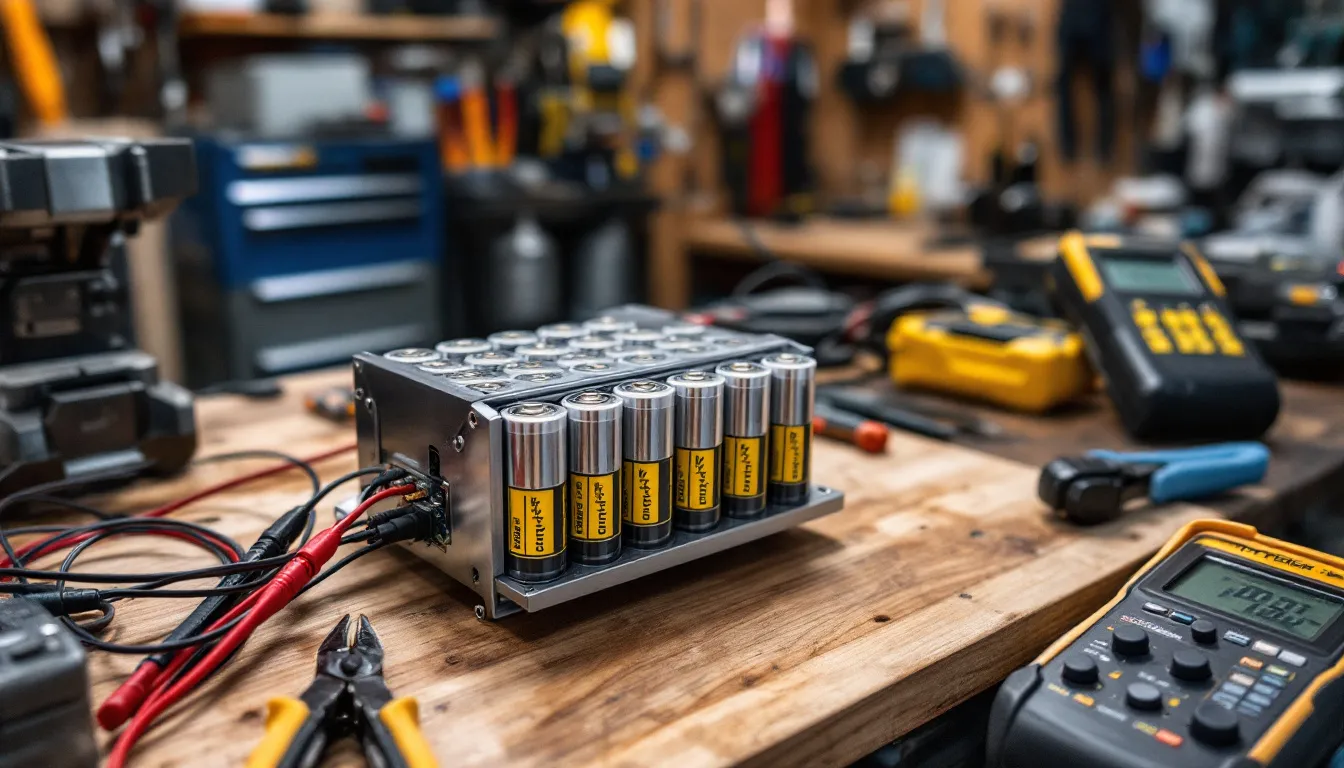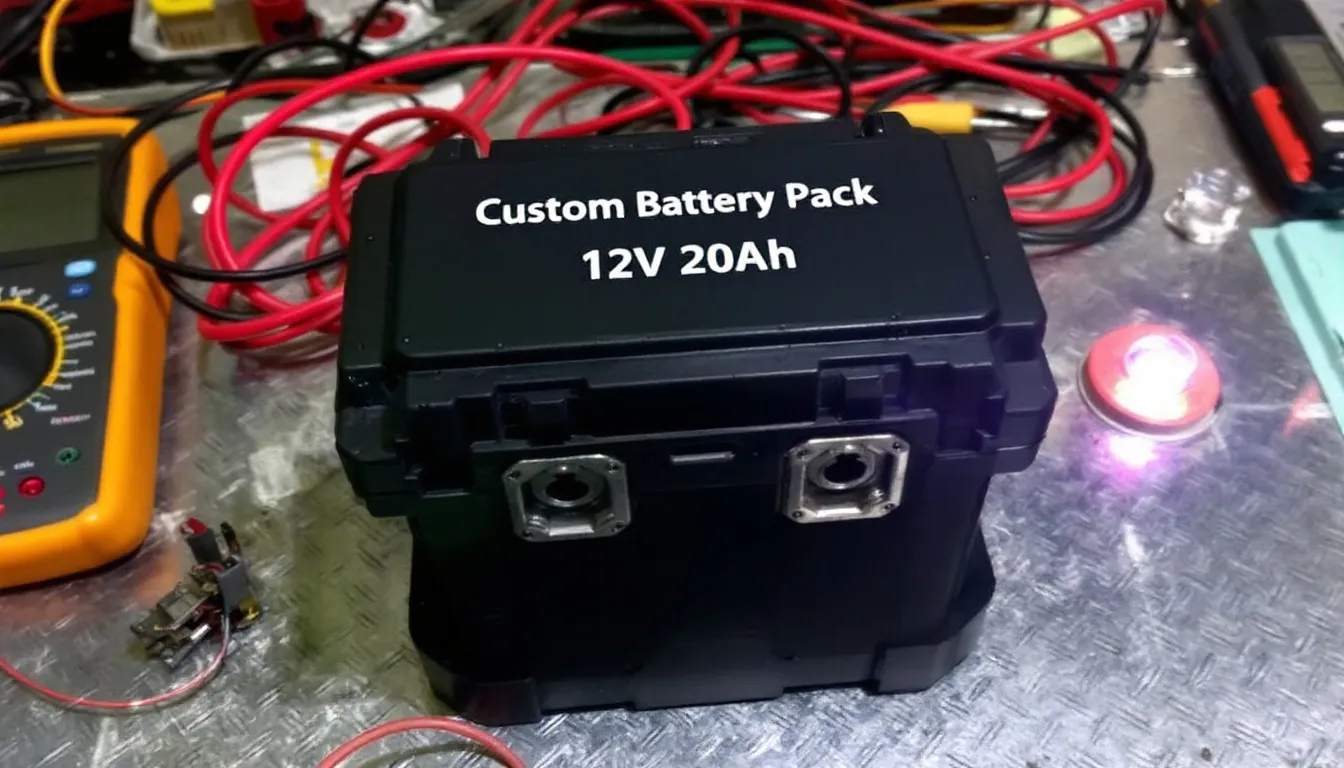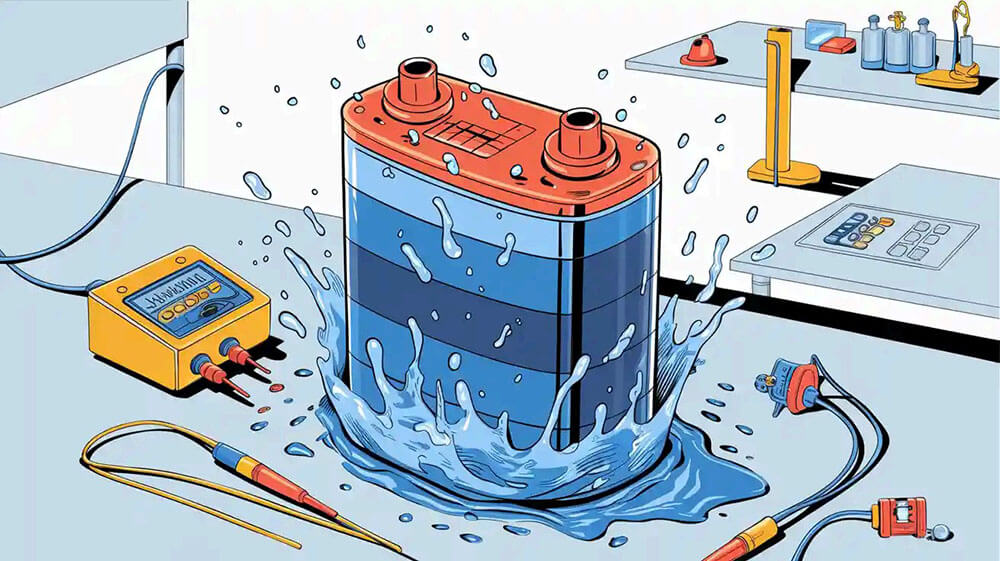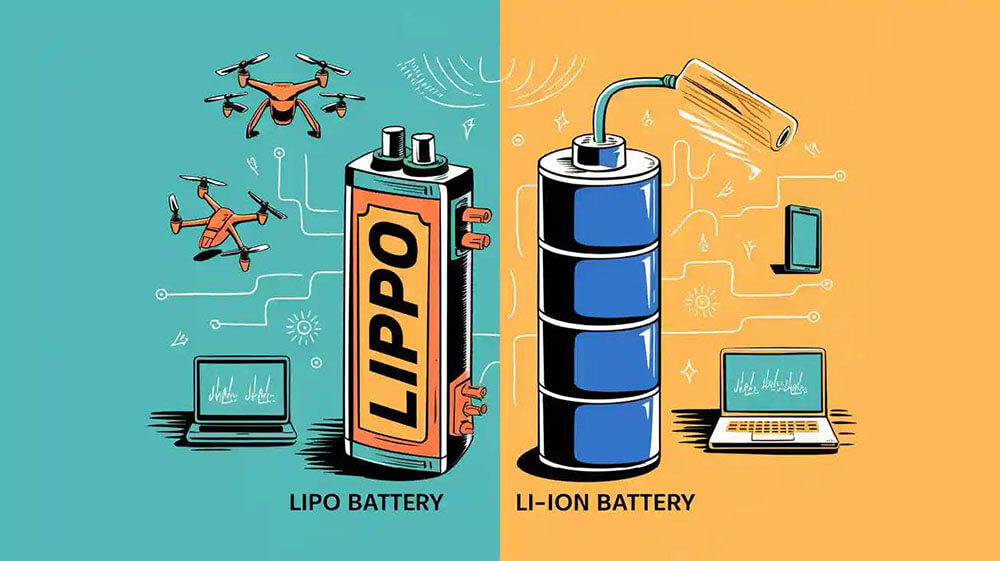Contents
- DEFINING YOUR CUSTOM BATTERY PACK REQUIREMENTS
- OPTIMIZING BATTERY PACK DESIGN AND CONFIGURATION
- SELECTING THE RIGHT CELLS AND MATERIALS
- INTEGRATING A SMART BMS FOR PERFORMANCE AND SAFETY
- BUILDING AND TESTING A SAMPLE CUSTOM LITHIUM BATTERY PACK
- PRODUCTION, CERTIFICATION, AND LONG-TERM SUPPORT
- CONCLUSION
- FAQs
Custom Battery Solutions for Specialized Applications Custom battery pack manufacturing involves a collaborative design process with our team and customers from concept through testing to large-scale manufacturing.
Electric bike projects generate over $300,000 on Kickstarter, showcasing high demand for custom battery packs across today’s markets. CUSTOM BATTERY PACKS deliver precise power solutions when standard options fail to match your customers’ requirements.
Standard battery packs provide minimal flexibility with fixed voltage outputs – 3.6V, 7.2V, 12V, or 24V. Custom lithium battery packs offer exact specification designs for unique applications. 18650 battery packs excel in high-capacity needs. Battery pack design requires multiple technical considerations. Complex configurations like 12s8p 21700 packs and extreme environment solutions demonstrate unlimited customization possibilities.
This article reveals professional insights for custom battery pack performance optimization. We’ll examine critical aspects from requirements definition to BMS integration, cell selection strategies, and essential testing procedures. Collaboration with customers is essential in the design of custom battery packs. Every system we design leverages our cross-industry expertise to meet your precise power specifications. Our team takes great pride in their work, emphasizing our commitment to quality and expertise in custom battery pack manufacturing.
DEFINING YOUR CUSTOM BATTERY PACK REQUIREMENTS
Custom battery pack success requires precise requirement definition before design begins. Involving engineers in the early stages of the design process helps define precise requirements for custom battery packs. Battery packs must match application needs – from power specifications to environmental conditions. Clear parameter definition creates optimal performance.
Voltage, Capacity, and Amperage Targets
Three fundamental power specifications form the foundation of custom battery pack design. Specialized battery packs can be designed for both small and large production runs, emphasizing flexibility in meeting client needs.
Voltage requirements determine electrical “pressure” for your device. Each battery chemistry provides specific nominal voltage when charged. Lithium-ion cells deliver approximately 3.6-3.7V, NiMH cells provide 1.2V, NiCad cells offer 1.2V, and lead-acid cells produce 2.0V.
Voltage changes throughout discharge:
- Fully charged: Lithium-ion reaches 4.2V, NiMH and NiCad reach 1.4V, lead-acid hits 2.1V
- Fully discharged: Lithium-ion shouldn’t fall below 2.5-3.0V, NiMH and NiCad safely reach 1.0V, lead-acid discharges to 1.75V
Total voltage calculation: multiply individual cell voltage by series-connected cells. Four lithium-ion cells in series provide 14.8V (3.7V × 4), ten NiMH cells produce 12V (1.2V × 10).
Capacity measurement uses amp-hours (Ah) or milliamp-hours (mAh). This dictates operation time before recharging. Calculate by multiplying device power draw (watts) by desired runtime (hours). Example: 50-watt device running 4 hours needs 200 watt-hour battery pack.
Amperage needs reflect current draw during operation. This determines cell discharge rate requirements. Applications vary between steady low current and high current bursts.
Form Factor Constraints and Environmental Conditions
Physical dimensions impact design decisions. Three form factors dominate custom lithium battery markets:
Cylindrical cells (18650) offer superior thermal performance with beneficial surface-to-volume ratio, creating cooling pathways between cells. Standardized manufacturing provides cost advantages despite lower volumetric efficiency.
Prismatic cells use stacked layer configuration, facilitating heat dissipation and maximizing available volume. These rectangular cells provide excellent space utilization, gaining popularity in large-format applications with cell-to-pack designs for improved energy density.
Pouch cells utilize sealed flexible foil containers, reducing weight and enabling adaptable shapes. These achieve 90-95% packaging efficiency but require support structures and swelling allowance (8-10% after 500 cycles).
Environmental conditions require careful consideration. Battery packs must withstand temperature, humidity, vibration, dust and water exposure. High-temperature environments benefit from prismatic cells with superior thermal management.
Additionally, the ability to manufacture custom battery packs tailored to specific environmental conditions ensures optimal performance and durability.
Safety Priorities and Regulatory Needs
Safety features remain non-negotiable for lithium-based chemistries vulnerable to thermal runaway. Essential safety features include:
- Overcharge protection with specific voltage cutoffs (maximum 3.65V for LiFePO4)
- Short circuit detection responding under 1ms
- Cell balancing systems maintaining even voltage levels
- Thermal management preventing overheating
- Liquid cooling systems for high-power applications
Custom battery packs must meet various regulatory standards. UN38.3 certification is mandatory for lithium battery transportation, requiring rigorous testing including altitude simulation, thermal tests, vibration, shock, external short circuit, impact/crush, overcharge, and forced discharge.
IATA regulations limit separately shipped lithium batteries to 30% state of charge. Applications may require additional standards – ISO 12405 for EV batteries, UL 2580 in US markets, or CE certification for EU distribution.
Thorough requirement definition establishes solid foundations for custom batteries and custom battery pack design, ensuring application-specific performance with safety and regulatory compliance.
It is crucial to meet regulatory standards in the USA, including UN38.3 certification and other relevant certifications, to ensure safe and legal operation.
OPTIMIZING BATTERY PACK DESIGN AND CONFIGURATION

Image Source: ResearchGate
Strategic cell arrangement directly impacts voltage, capacity, and thermal behavior. Custom battery pack design requires precise configuration beyond simply selecting cells. Proper design maximizes efficiency, performance, and battery lifespan.
The collaborative approach of our engineering team ensures that every aspect of the battery pack design is optimized for maximum efficiency and performance.
Technology: Serial, Parallel, and Hybrid
SERIES CONFIGURATIONS increase voltage while maintaining original capacity. Connecting the negative terminal of one cell to the positive terminal of the next multiplies voltage by cell count. Four 3.6V lithium-ion cells in series produce 14.4V nominal voltage.
PARALLEL CONFIGURATIONS boost capacity while voltage remains unchanged. All positive terminals connect together, as do all negative terminals. This arrangement multiplies amp-hours by the number of cells in parallel.
SERIES-PARALLEL HYBRID LAYOUTS combine both approaches for maximum flexibility. Industry notation “4s2p” indicates four cells in series and two in parallel. Laptop batteries typically use 4s2p configuration to reach 14.4V with doubled capacity.
Cell matching becomes critical in series configurations – the pack performs only as well as its weakest cell. High-voltage packs for electric bikes (36V-48V) require precise cell matching, particularly for high-current applications.
Physical Formats
CUBIC (B) FORMAT arranges cells in neat rows, creating rectangular packs. Dimensions follow the formula: nD × mD × H, where n represents cells per row, m equals rows, D is cell diameter, and H is cell height. This arrangement allows easier assembly and thermal design.
NESTED (C) FORMAT places cells in honeycomb patterns, improving space utilization. These configurations require outer shrink wrap for structural support and fish paper for cell protection. Better volumetric efficiency comes with more complex manufacturing.
CIRCULAR ARRANGEMENTS work well for cylindrical housings. Three-cell packs fit in tubes with diameter 2.15D, while four-cell configurations need approximately 2.41D tube diameter.
Pure nickel buss material with spot welding connects most cells. High-current applications demand special attention to buss material selection for proper conductivity.
Technology:Thermal Management
Heat management remains critical for custom battery packs. Lithium-ion cells operate safely between -20°C and 60°C, with optimal charging between 0°C and 45°C. Temperature extremes cause irreversible damage – lithium plating at low temperatures and thermal runaway at high temperatures.
Heat generation occurs through electrical resistance and chemical reactions. Discharge produces heat (exothermic) while charging absorbs heat (endothermic).
PASSIVE COOLING OPTIONS:
- Air cooling with heat sinks
- Heat pipe systems using refrigerant or water
- Phase change materials with heat-absorbent fillers
ACTIVE COOLING METHODS:
- Forced air cooling for moderate heat loads
- Liquid cooling plates for high-power applications
- Direct liquid cooling for extreme thermal demands
SELECTING THE RIGHT CELLS AND MATERIALS

Component selection forms the foundation of high-performing custom battery assemblies and packs. Cell choice and connection materials directly impact performance, safety, and longevity. These critical decisions determine success or failure for your custom lithium battery project.
We have the capability to produce battery assemblies across various chemistries and applications, showcasing our commitment to tailored solutions that meet intricate specifications for industries such as Defense, Aerospace, and Medical.
PANASONIC vs LG vs SAMSUNG Cell Performance
Major manufacturers dominate the lithium-ion market with distinct performance characteristics, offering high-performance cells from major manufacturers like Panasonic, LG, and Samsung. Japanese-made Sanyo/Panasonic NCR18650GA cells deliver 3491mAh at 0.2C discharge rates, outperforming competitors.
Performance differences magnify at higher discharge rates:
- Panasonic maintains 3295mAh at 5A discharge
- Samsung 35E delivers 3317mAh at 5A with higher cutoff voltage (2.65V vs 2.5V)
- LG MJ1 cells deliver 3258mAh at 5A discharge
Chinese manufactured Panasonic cells show slightly lower capacity (3448mAh vs 3491mAh) than Japanese counterparts. Electric bike applications highlight these differences – Samsung cells maintain consistent performance at 8A discharge while LG cells experience greater capacity loss.
CELL GRADE QUALITY CLASSIFICATION
Manufacturers sort cells into quality grades affecting battery pack performance:
GRADE A CELLS provide superior energy density, minimal internal resistance, maximum capacity. Ideal for electric vehicles where safety and performance are paramount. These cells typically power battery packs with 5-7 year warranties.
GRADE B CELLS offer reasonable performance with moderate internal resistance. Suitable for consumer electronics or backup power systems where cost sensitivity outweighs performance demands. Battery packs using B-grade cells typically carry 2-3 year warranties.
GRADE C CELLS have highest internal resistance and lowest capacity. Suitable only for non-critical applications.
Cell matching dictates pack longevity. Capacity tolerance between cells should not exceed ±2.5 percent in industrial batteries. Mismatched cells create hotspots when stronger cells compensate for weaker ones, accelerating degradation. Cell mismatch remains a primary cause of early pack failure.
NICKEL STRIP REQUIREMENTS
Connection materials significantly impact electrical performance and safety. Nickel strips create low-resistance cell connections with proper dimensioning essential.
Strip thickness directly correlates with current capacity:
- 0.15mm thick nickel strips handle 5-10A
- 0.2mm strips manage 10-15A safely
Width provides larger contact surface area, reducing resistance and heat generation. Pure nickel (Ni200/N6 grade with 99.7% purity) delivers lower resistance than nickel-plated steel, minimizing heating and energy loss.
High-current applications require multiple parallel strips or layered connections. A single 0.2 × 8mm layer handles approximately 10A; two layers increase capacity to 18A. Battery packs experiencing 60-75A current draws need multiple connection points distributed evenly across parallel cell groups for safer operation.
Properly sized connection materials prevent dangerous hotspots that lead to thermal runaway, ensuring your custom battery pack delivers optimal performance and safety.
INTEGRATING A SMART BMS FOR PERFORMANCE AND SAFETY

Image Source: ResearchGate
Battery Management Systems (BMS) function as the central intelligence of custom battery packs, continuously monitoring operations and ensuring safety parameters remain within acceptable limits. Most lithium and NiMH custom battery packs require a BMS system. This essential component extends battery life while preventing potential catastrophic failures across multiple applications.
In addition to BMS, our comprehensive approach to energy solutions includes the design and manufacturing of chargers, ensuring a complete and innovative solution for powering sustainable technologies.
MONITORING: VOLTAGE, SOC, SOH, AND TEMPERATURE
Smart BMS systems track individual cell voltages in real-time enabling precise cell balancing – critical for maximizing usable capacity throughout the battery lifecycle. Setting the correct float voltage for lithium batteries is essential, and BMS can ensure this accuracy. Temperature monitoring prevents dangerous overheating conditions in lithium-ion batteries.
State of Charge (SOC) calculations deliver immediate information about remaining power levels. Users receive accurate assessment of available energy. State of Health (SOH) measurements indicate the battery’s current storage and delivery capabilities compared to original specifications. These metrics predict performance trends and degradation patterns.
Advanced systems transmit data to cloud platforms for comprehensive analysis, enabling predictive maintenance and performance enhancement.
PROTECTION FEATURES: OVERCURRENT, UNDERVOLTAGE, SHORT CIRCUIT
Safety mechanisms form the core BMS functionality. Overcurrent protection blocks excessive current flow that damages components or generates dangerous heat. Protection activates within milliseconds of detecting unsafe conditions.
Under-voltage protection prevents battery depletion below critical thresholds – lithium-ion cells should never drop below 2.5-3.0V. Short circuit protection represents another vital safety feature, engaging during fault conditions with immediate current surges.
These protection systems work collaboratively rather than independently, creating comprehensive safety monitoring across all battery conditions. The integrated approach prevents catastrophic failures while optimizing performance.
COMMUNICATION PROTOCOLS: SMBUS, BLUETOOTH, CAN
Communication protocols enable seamless data exchange between BMS and system components. CAN Bus (Controller Area Network) maintains position as the most widely adopted protocol, recognized for superior error handling and fault tolerance. Its multi-master architecture allows different nodes to transmit data without requiring dedicated master nodes, creating a decentralized approach with enhanced stability.
Bluetooth delivers wireless capabilities with minimal power consumption, ideal for portable systems requiring remote monitoring. Users check battery status and adjust performance settings via smartphone apps. Many custom packs utilize JBD, ANT, or LLT BMS systems featuring Bluetooth connectivity.
Protocol selection depends on application-specific requirements including data speed needs, communication distance, and integration complexity.
BUILDING AND TESTING A SAMPLE CUSTOM LITHIUM BATTERY PACK

Battery design specifications mark only the first step in development. Creating and testing functional prototypes represents the critical phase where theoretical designs face practical reality. We’re not just planning on paper—we’re validating real performance.
For consultations or additional information about custom battery solutions, please reach out via email.
Creating a Prototype Based on Spec Sheet
Prototype development translates technical specifications into a functional battery pack. Technical dossier preparation includes mechanical configurations, electrical schematics, and detailed 2D/3D drawings. 3D printed enclosures test mechanical form and fit, validating physical design before production tooling commitment. Battery pack prototyping can be achieved swiftly, allowing for quick adjustments based on testing results. This comprehensive documentation enables manufacturers to procure custom components and start prototype production.
Testing for Voltage Consistency and Load Handling
Battery load testing remains essential for performance evaluation under controlled conditions. Our testing process follows five key steps:
- Full charge battery preparation at recommended temperature
- Connection to calibrated load testing equipment
- Controlled load application for predetermined duration
- Continuous voltage and performance monitoring
- Result analysis for battery condition assessment
Healthy batteries maintain stable voltage within acceptable parameters. Significant voltage drops indicate capacity issues or internal resistance problems. Load testing reveals peak demand handling capability—vital for applications requiring sudden power bursts.
Iterating Based on Real-World Performance
Field testing identifies issues invisible during lab evaluation. Simulated environments show how batteries function under authentic usage patterns. This approach enables assessment of:
- Cell connections under expected current loads
- Operation heating patterns
- Actual versus theoretical capacity
- BMS response in varying conditions
Performance data drives design refinement. Thermal management adjustments, cell configuration modifications, or connection method improvements often result from initial testing. Extensive field operation analysis confirms the battery meets real-world scenario demands.
This development cycle produces custom battery packs with reliable performance for specific application requirements.
PRODUCTION, CERTIFICATION, AND LONG-TERM SUPPORT
Custom battery pack manufacturing requires rigorous certification processes. These essential protocols guarantee safety and legal compliance throughout product lifecycle.
UN38.3 and CE CERTIFICATION REQUIREMENTS
UN38.3 certification stands as MANDATORY requirement for all lithium battery transportation. This applies to standalone batteries, individual cells, and products with installed batteries. International standards demand eight rigorous tests:
- Altitude simulation
- Thermal testing
- Vibration
- Shock
- External short circuit
- Impact testing
- Overcharge
- Forced discharge
Certification process spans 4-12 weeks depending on testing organization. This timeline must factor into production schedules. European markets require CE Marking as self-declaration of EU safety standards compliance.
QUALITY CONTROL: Vibration and Discharge Testing
Vibration testing forms cornerstone of battery quality assurance. UN38.3 standards specify 3-hour sine sweep across three axes. Electric vehicle applications follow more comprehensive ISO 19453-6 standards.
Quality control protocols include complete battery cycling – charging and discharging packs to verify:
- State of health
- Charge levels
- Internal impedance measurements
These rigorous tests identify potential issues before customer delivery, ensuring total reliability throughout battery lifespan.
WORKING WITH CUSTOM BATTERY PACK MANUFACTURER
Selecting optimal manufacturing partner requires evaluation of certification capabilities, production facilities, and quality systems. Our manufacturing partners develop detailed technical documentation including mechanical configurations and electrical schematics.
Top-tier manufacturers maintain ISO 9001 certification and conduct extensive testing before shipment. Their regulatory expertise streamlines certification processes through established relationships with accredited testing laboratories.
Production quality assurance combines manual inspection and automated testing systems for performance verification under varying loads. We require documented testing results demonstrating complete compliance with specifications and all applicable safety standards.
CONCLUSION
Custom battery packs excel where off-the-shelf solutions fall short. Precise requirement definition establishes the foundation for success – voltage targets, capacity needs, and amperage demands form the starting point. Physical configuration choices between series, parallel, and hybrid layouts directly determine performance quality and operational lifespan.
Cell selection stands as the critical decision point for any custom battery project. Premium lithium ion cells from Panasonic, Samsung, and LG show measurable performance advantages during demanding discharge conditions. Proper nickel strip thickness and connection methods prevent dangerous hotspots while ensuring maximum power delivery efficiency.
Battery Management Systems function as the essential intelligence center of every custom pack. These systems monitor vital parameters and provide critical protection features. Without proper BMS integration, even expertly designed battery packs fail to deliver optimal performance and safety.
Prototype testing reveals real-world characteristics impossible to predict through theoretical design alone. This methodical process yields reliable power solutions tailored to specific application requirements.
Certification standards including UN38.3 and CE marking ensure both safety compliance and legal operation throughout your battery pack’s service life. For your next custom battery design project, contact Large Power to benefit from our 20+ years of cross-industry expertise in navigating these complex technical requirements.
FAQs
Q1. What are the key considerations when designing a custom battery pack? The main factors to consider are voltage and capacity requirements, physical size constraints, environmental conditions, safety features, and regulatory compliance needs. Carefully defining these parameters upfront is crucial for optimal performance.
Q2. How do different cell configurations affect battery pack performance? Series connections increase voltage while parallel connections boost capacity. Hybrid series-parallel layouts offer flexibility to achieve specific voltage and capacity targets. The physical arrangement (cubic, nested, or circular) impacts thermal management and manufacturing complexity.
Q3. What role does cell selection play in custom battery packs? Choosing the right cells is critical. Major manufacturers like Panasonic, LG, and Samsung offer cells with distinct performance characteristics. Matching cell grades and chemistry is essential for pack longevity and safety. Higher grade cells typically provide superior energy density and longevity.
Q4. Why is a Battery Management System (BMS) important for custom battery packs? A BMS is crucial for monitoring voltage, state of charge, and temperature. It provides critical protection against overcurrent, undervoltage, and short circuits. Advanced BMS systems also enable data communication for performance optimization and predictive maintenance.
Q5. What testing is necessary before finalizing a custom battery pack design? Prototype testing is essential to validate performance. This includes evaluating voltage consistency, load handling capabilities, and real-world performance in simulated environments. Iterative testing and refinement based on results helps ensure the final design meets all requirements reliably.





